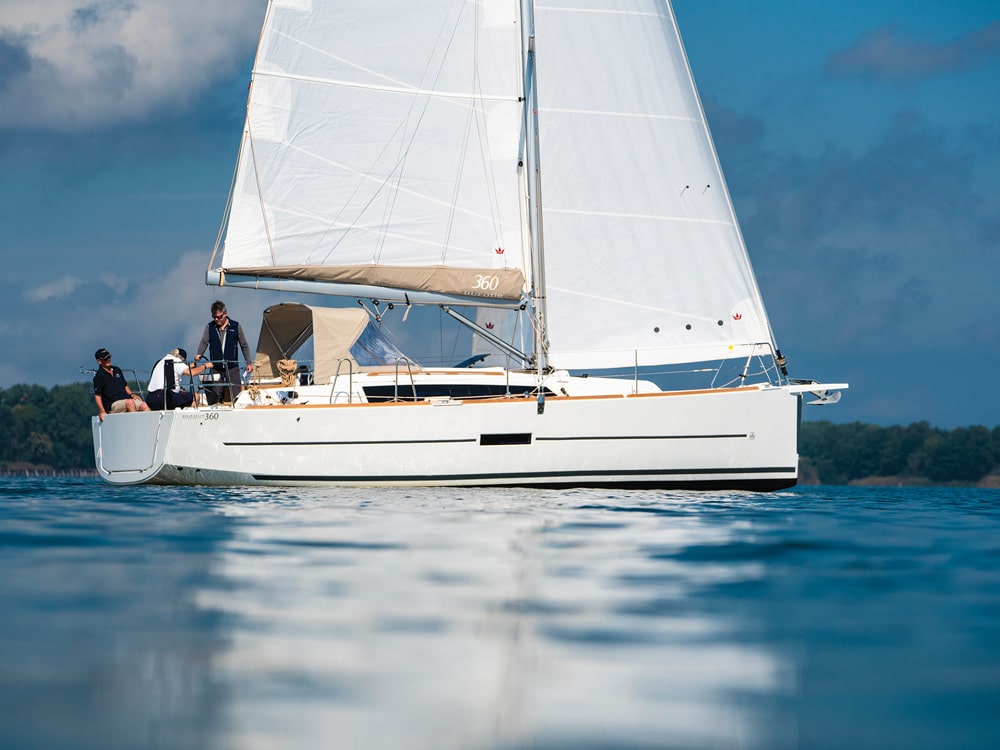
Dufour Yachts introduced its new 360 Grand Large model to CW‘s Boat of the Year team last fall as a coastal cruiser intended for a couple or perhaps a small family. With that in mind, judge Alvah Simon found numerous clever elements to praise within the boat’s 35-foot-2-inch hull — a relatively modest LOA compared to the many 40-, 50- and 60-footers on display at the U.S. Sailboat show in Annapolis, Maryland.
Simon, who’s sailed around the world and then some in his own 36-footer, appreciates practicality afloat and found the boat’s two-sleeping-cabin layout much to his liking, especially since it wasn’t readily apparent which was intended for those paying the bills. “You didn’t have this owner’s cabin and then a little cubbyhole with a bunch of places to hit your head,” he noted.
Instead, the V-berth had a roomy feel to it, with double doors that open wide, an opening hatch overhead and a forward-facing portlight where the cabin top curves down to meet the foredeck. Aft, to port, a second cabin also sported considerable headroom, a large hanging locker and a generously sized bunk suitable for a couple of adults or a handful of toddlers.
This arrangement let the builder locate a large head and shower opposite, with storage behind that can also be accessed from the cockpit above. A full-size nav station is to starboard, just forward of the companionway steps, with an L-shaped galley opposite, and there’s still room in the saloon for a large centerline drop-leaf table and two sea berth-length settees to either side. (There is also a three-cabin layout, but it shrinks the size of the nav station and moves it forward, cutting into the starboard settee, to accommodate the head.)
Sailing, a long seat spans the stern and gives the helmsman multiple places to sit behind the twin wheels.
Simon also had words of praise for how the designer, Felci Yachts, and the Dufour team made the most of the boat’s plumb transom. Sailing, a long seat spans the stern and gives the helmsman multiple places to sit behind the twin wheels. At the dock or when anchored with the swim platform down, the starboard side of the seat folds up out of the way; the port side opens to reveal a sink, propane locker, stainless-steel grill and life-raft locker.
“They’re really starting to use this space wisely,” says Simon. “It’s not just big lazarettes for fenders anymore.”
Adding to the sense of space aft is the lack of a backstay, made possible by the 360’s swept-back twin spreaders and stays anchored to the sheer. The boat comes with a couple of options for headsails, either a self-tacking jib or, in the case of the boat we sailed, a 107-percent overlapping genoa, with fairleads that can be adjusted by lines led to the cockpit. An optional sprit is also available for flying off-wind sails. Halyards, vang and reef lines are brought aft to the cockpit under the coachroof, keeping the deck clutter free. A double-ended main sheet is led to the primary winches mounted just forward of the twin wheels, making single handing quite manageable.
The breeze was light on the day we took the 360 for a sail. In about 4 knots of wind, the GPS speed was just over 2 knots closehauled and about 2 1/2 knots on a reach.
The base price for the boat is $155,000. Our test boat had an upgraded 29 hp Volvo (an 18 hp engine comes standard), which, with a few other options, pushed the price tag to $197,000. If I were buying the boat, I’d definitely consider the bigger power plant. As it was, in calm conditions, it pushed us along at just 6 knots at cruising rpm (2,400) and 6.8 knots wide open.
“The steering under power and sail was really quite nice,” noted BOTY judge Tim Murphy, describing his time on the wheel. “She backed beautifully under power in both directions.” For a couple looking to do some sailing with friends or the kids, what more could you ask for?
Mark Pillsbury is CW’s editor.








